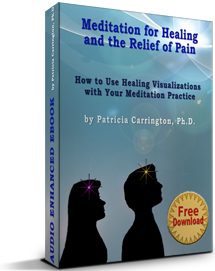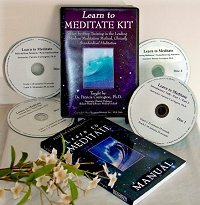Dr. Patricia Carrington's award winning meditation technique CSM (Clinically Standardized Meditation) is a clinically sensitive meditation method developed by the Medical Department of New York Telephone Company and used by numerous medical institutions, organizations, and individuals worldwide. For information click here.
Tips for Success in Meditating
Correct Postures for Meditating
Patricia Carrington, Ph.D.
Author of “The Book of Meditation”
It is often said that the lotus position is the ideal posture for meditation, even though it is certainly not easy for many Westerners. However, while it is the prescribed posture for persons studying advanced forms of meditation (often with the aim of furthering spiritual development), unless someone has been carefully trained in Yoga or Zen, it is usually more satisfactory for people to meditate sitting in a chair.
Even in a chair, however, the question of posture in meditation remains important.
An uncomfortable sitting position can distract a meditator so that it cancels out the benefits of meditation. Some chair-sitting meditators complain, for example, that their head involuntarily drops forward when they go into a deeper meditation state, which in turn pulls on the neck muscles and can increase an already existing back or neck problem. This can quite effectively spoil a meditation session. For such people one solution may be to sit in a chair with a high enough back so that their head can rest comfortably against it when meditating, or if they like to sit on the floor, leaning back against the wall may be a good solution. TM teachers, however, feel that one should not support the head because this may encourage sleep; teachers of Zazen feel that one should not lean against walls or backs of chairs;1 and writers on Yoga meditation advise their followers not to lean back against the furniture while meditating because it is ‘important to your health’.2 People who have tried supporting their neck because they felt they needed it, however, have not reported that this made their meditation any less effective or that they felt in any way more sleepy. Once again, this seems to be an individual matter as far as practical meditation is concerned.
As for meditating lying down, this position is associated with sleep and for many of us dropping off to sleep is an automatic response to lying down quietly with eyes closed. Nevertheless, the classic Yoga posture, salvasana, which clearly evokes a meditative mood, is performed lying on the back, as are many of the autogenic training exercises. Baba Ram Dass, for example, advises his students to lie down for certain meditations if reclining does not lead to sleep.3 It is therefore certainly possible to consider lying down when meditating if this becomes necessary. This is important to realize, because occasionally people find that meditating while lying down, or partially lying down with head and back just slightly propped up, is for them the only feasible position. People who feel they must meditate this way seem the least likely to fall asleep during meditation when lying down. Perhaps such people are intuitively aware of certain physiological or psychological needs which make lying flat their best position.
As indicated, this advice refers only to the practical forms of meditation. Spiritual meditation always requires a certain prescribed posture, usually the lotus position or some variation of it, and the very process of mastering it becomes a form of meditation for the devotee. Since so many of the great meditative traditions insist on the importance of the proper grounding of the person in the pyramidal shape before ‘true’ meditation can be said to take place, it is possible that certain deep states can only be obtained this way.
The practical meditator, however, should decide for herself what goals are appropriate for meditative practice and select the form and level of the discipline that best suit these aims. An average tennis player has no need of a four-hour workout every day if he simply wants to play on weekends with friends. A tennis pro, on the other hand, may have to practice more than this, and this practice will be highly specific and designed to overcome special problems. Meditation postures follow the same rules – the higher one sets one’s sights in terms of personal and/or spiritual development, the more rigorous and exacting the postures must be. In the practical forms of meditation there are many options with regard to the best position. Ultimately each meditator must decide for himself which is most suitable.
1. P. Wienphal, The Matter of Zen (New York: New York University Press, 1946), p. 22.
2. M. Sadhu, Meditation (Hollywood: Wilshire Books, 1973), p. 97.

